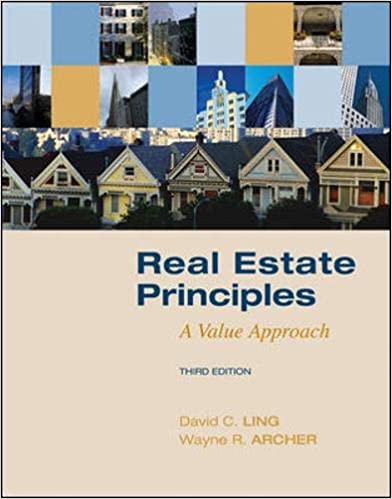
Real Estate Principles 3rd Edition by David Ling,Wayne Archer
Edition 3ISBN: 978-0073377322
Real Estate Principles 3rd Edition by David Ling,Wayne Archer
Edition 3ISBN: 978-0073377322 Exercise 17
Compute the after-tax cash flow from the sale of the following nonresidential property:
• The purchase price was $450,000.
• The investor obtained a $360,000 loan.
• There were no up-front financing costs.
• The market value of the property increased to $472,500 over the two-year holding period.
• Selling costs are 6 percent of the sales price.
• The investor is in the 35 percent ordinary tax bracket.
• Capital gains will be taxed at 15 percent.
• The balance of the loan at the time of sale is $354,276.
• 15 percent of the initial purchase price represented the value of the land. The remaining 85 percent has been depreciated using straight-line depreciation and a 39-year cost recovery period.
• $30,000 in capital expenditures has been incurred since acquisition; for simplicity, however, the capital expenditures have been added to the tax basis but not separately depreciated.
a. Compute the annual depreciation deduction.
b. Compute the adjusted basis at the time of sale (after two years).
c. Compute the tax liability from sale.
d. Compute the after-tax cash flow (equity reversion) from sale.
• The purchase price was $450,000.
• The investor obtained a $360,000 loan.
• There were no up-front financing costs.
• The market value of the property increased to $472,500 over the two-year holding period.
• Selling costs are 6 percent of the sales price.
• The investor is in the 35 percent ordinary tax bracket.
• Capital gains will be taxed at 15 percent.
• The balance of the loan at the time of sale is $354,276.
• 15 percent of the initial purchase price represented the value of the land. The remaining 85 percent has been depreciated using straight-line depreciation and a 39-year cost recovery period.
• $30,000 in capital expenditures has been incurred since acquisition; for simplicity, however, the capital expenditures have been added to the tax basis but not separately depreciated.
a. Compute the annual depreciation deduction.
b. Compute the adjusted basis at the time of sale (after two years).
c. Compute the tax liability from sale.
d. Compute the after-tax cash flow (equity reversion) from sale.
Explanation
We are asked to use the provided informa...
Real Estate Principles 3rd Edition by David Ling,Wayne Archer
Why don’t you like this exercise?
Other Minimum 8 character and maximum 255 character
Character 255


